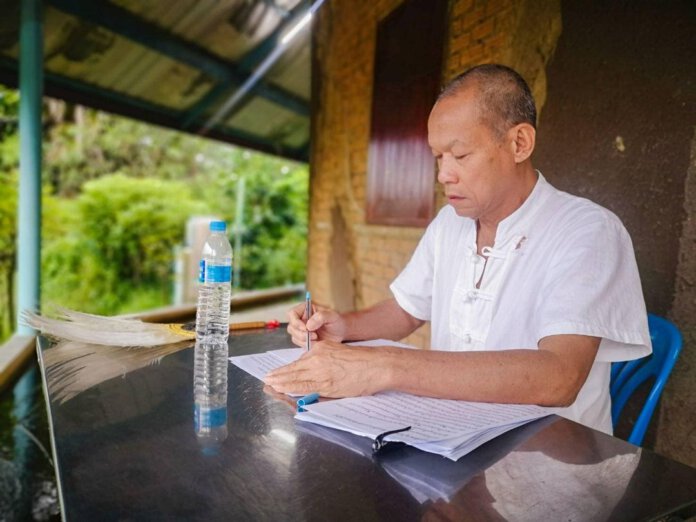เผื่อว่าอ่านแล้วไม่เข้าใจ จะได้หายสงสัย (ตอนที่ ๓)
๑๑ กันยายน ๒๕๖๔
จะพยายาม อธิบายความให้กระจ่างเท่าที่สติปัญญาอันน้อยนิดพอจะทำได้
“ดูกรภิกษุทั้งหลาย เราอนุญาต พวกเธอจงเที่ยวจาริกไปเพื่อประโยชน์แก่ชนเป็นอันมาก เพื่อความสุขแก่ชนเป็นอันมาก เพื่ออนุเคราะห์สัตว์โลก เพื่อประโยชน์ เพื่อเกื้อกูล เพื่อความสุขแก่เทพดาและมนุษย์ทั้งหลาย แต่อย่าได้ไปทางเดียวกันสองรูป ภิกษุทั้งหลาย เธอทั้งหลายจงแสดงธรรมงามในเบื้องต้น งามในท่ามกลาง งามในที่สุด จงประกาศพรหมจรรย์ พร้อมทั้งอรรถ พร้อมทั้งพยัญชนะ บริสุทธิ์บริบูรณ์สิ้นเชิง ในโลกนี้ สัตว์พวกที่มีกิเลสเพียงดังธุลีในจักษุเบาบางยังมีอยู่ เพราะไม่ได้ฟังธรรม สัตว์พวกนั้นจึงเสื่อมเสียไป ผู้ที่รู้ทั่วถึงธรรมได้ยังจักมี แม้เราก็จักกระทำ โดยที่ให้พระนครพันธุมดีเป็นสถานที่อันเธอทั้งหลายพึงกลับมาแสดงพระปาติโมกข์โดยหกปีๆ ล่วงไป ดังนี้ ฯ”
อธิบายคำว่า งามในท่ามกลาง หมายถึง พฤติกรรมของภิกษุผู้ประกาศพระสัทธรรม นอกจากจะมีกิริยาสำรวม สังวร ระวัง และรู้จักประมาณตน ประเมินสถานการณ์แล้วยังต้องประมาณในการบริโภคปัจจัย ๔ อีกด้วย ทั้งยังต้องพากเพียรปฏิบัติตามพุทธโอวาทอย่างเคร่งครัด
รวมทั้งต้องทำหน้าที่ของผู้เผยแผ่พระสัทธรรมโดยสุจริต ดังเช่นพุทธสุภาษิตที่ว่า
ธมฺมํ จเร สุจริตํ น ตํ ทุจฺจริตํ จเร
(“พึงประพฤติธรรมให้สุจริต ไม่ควรประพฤติให้ทุจริต”)
เรียกว่า รู้อย่างไรสอนอย่างนั้น ดังตัวอย่างเช่น
พระอัสสชิเถระที่สนทนาแสดงธรรมแก่อุปติสสมาณพ ซึ่งต่อมาได้นามใหม่ว่า พระสารีบุตร
เย ธมฺม เหตุปฺปภวา เตสํ เหตุง ตถาคโต
เตสญฺ จ โย นิโรโธ จ เอวํวาที มหาสมโณ
ธรรมเหล่าใดเกิดแต่เหตุ พระตถาคตตรัสเหตุแห่งธรรมเหล่านั้น และการดับเหตุแห่งธรรมเหล่านี้ พระมหาสมณะมีวาทะอย่างนี้
สอนอย่างไร ทำอย่างนั้น
ตัวอย่างเช่น พระมหากัสสปเถระ ที่ท่านมีพระจริยาวัตรที่สันโดษ ยินดีในสิ่งที่พึงมี พึงได้ ไม่ฟุ้งเฟ้อ ไม่ทะยานยาก แม้แต่จีวรของท่านจะเก่าคร่ำคร่า ปะแล้วปะอีกอย่างไร ก็ไม่อาทร ไม่ขวนขวายจนกลายเป็นภาระของสมณสารูป ถึงขนาดพระบรมศาสดายกย่องว่าท่านเป็นผู้มีธรรมอันเสมอพระองค์
ทั้งยังทรงประทานจีวรให้แก่ พระมหากัสสปเถระ
เหล่านี้คือบุคคลต้นแบบของผู้มีสุจริตธรรม
อีกทั้งยังรู้จักหยิบยกเอาพระสัทธรรมที่เหมาะสมกับบุคคลชุมชนนั้นๆ มานำเสนอ แสดง แถลงอธิบายความให้ผู้สดับได้รับฟัง รับรู้ เข้าใจได้ถี่ถ้วน ลึกซึ้ง จนผู้ฟังสามารถกำจัดความไม่รู้ ไม่เข้าใจเสียได้
ทำอย่างไร พูดสอนอย่างนั้น ไม่เป็นคนเสแสร้ง ตลบตะแลง ต่อหน้าอย่าง ลับหลังอีกอย่าง
พุทธะอิสระ
————————————————-
เผื่อว่าอ่านแล้วไม่เข้าใจ จะได้หายสงสัย (ตอนที่ ๑)
เผื่อว่าอ่านแล้วไม่เข้าใจ จะได้หายสงสัย (ตอนที่ ๒)
————————————————-
Here is explanation just in case you did not understand after reading. (Part III)
September 11, 2021
I will try to explain based on my little wisdom.
“You, O Bhikkhus, I permit you to wander, for the gain of the many, for the welfare of the many, out of compassion for the world, for the good, for the gain, and for the welfare of gods and men. Let not two of you go the same way. Preach, O Bhikkhus, the doctrine, which is glorious in the beginning, glorious in the middle, glorious at the end, in the spirit and in the letter. Proclaim a consummate, perfect, and pure life of holiness. There are beings whose mental eyes are covered by scarcely any dust, but if the doctrine is not preached to them, they cannot attain salvation. They will understand the doctrine. And I will also go to preach the doctrine. Panthumadee City shall be the place for all of you to chant the Fundamental Precepts in the next six years.”
Further explanation on “glorious in the middle”. Glorious in the middle means monks to propagate Buddhist principles should be self-controlled, restrained, cautious of circumstances as well as moderate in consuming the four requisites. They must also persevere to strictly adhere to the Buddha’s teaching.
They must also honestly propagate the Buddha’s teachings according to the following Buddhist proverb.
“One shall adhere to meritorious deeds and shall not commit any immoral deed.”
Namely, one shall teach what he knows of.
For instance, the Elder Assaji who preached the following sermon to a young lad named Upatissa (later named Sariputta, the chief disciple of the Buddha).
“Of all those things that arise from a cause, the Buddha has told their causes.
And he has also told how they cease to be. This is the doctrine of the Great Recluse.”
One shall behave exactly as he has taught others.
For example, Venerable Maha Kassapa, who was a strict observer of the austerity practices. He was pleased with what he possessed and did not have any desire. Even though his monk robes were so obsolete and sewn many times, he did not care to ask for a new one. The Buddha even praised that Venerable Maha Kassapa to have equal merit as him.
The Buddha also gave his monk robe to Venerable Maha Kassapa.
These are role models of people with honesty.
They knew to raise the Buddha’s teaching which is appropriate for that community, and they can present, showcase, and explain them thoroughly and deeply that listeners are liberated from their ignorance.
They did what they had taught. They were not pretentious and deceitful. They behaved the same both in front of and behind others.
Buddha Isara
————————————————-
Here is explanation just in case you did not understand after reading. (Part I)
Here is explanation just in case you did not understand after reading. (Part II)






